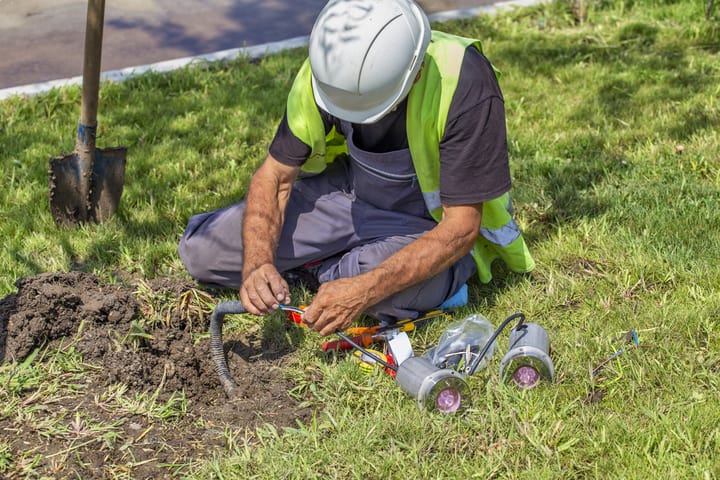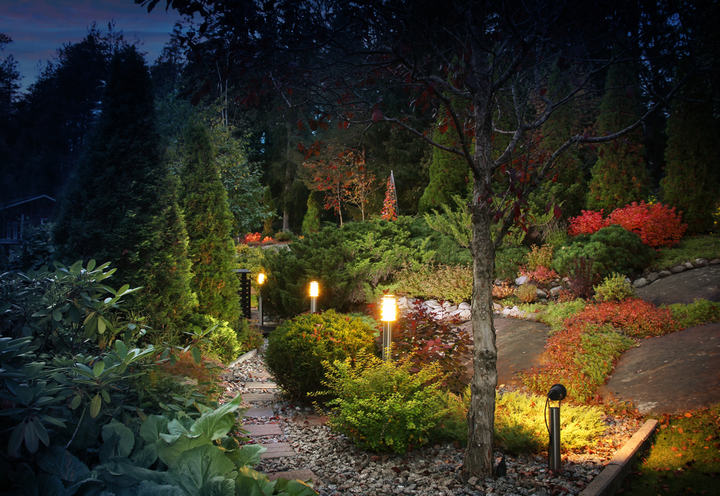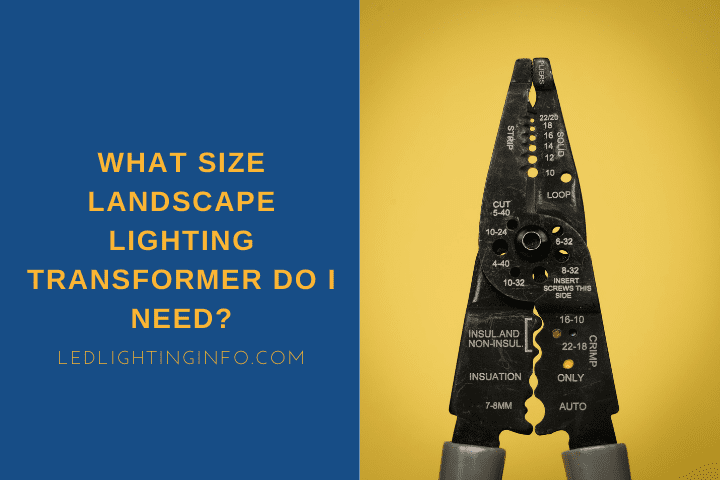Choosing a suitable transformer for your landscape lighting setup is critical.
It’s so easy to pick up an unreliable one or one that doesn’t meet the needs of your planned lighting.
In this article, I’m going to focus on the size of the transformer. That’s not the literal dimensions, but instead, the Wattage that it’s rated for.
You should pick a transformer rated for 25% more of the total Wattage of lights you intend to use. At the same time, avoid buying a transformer that’s way too big for your chosen lights – poorly regulated transformers can damage lighting if you don’t use enough bulbs.
To explain this in a bit more details, I’ll take you through:
- How to calculate the transformer you need
- How many lights you can add to a low voltage transformer
- Other considerations when choosing your transformer
What Size Transformer Do I Need For Landscape Lighting?

Low voltage lighting transformers will have a rated Wattage – this is the maximum total Watts of bulbs that you could add to the transformer.
Except that, ask any professional installer, and they’ll likely disagree.
You risk overloading the transformer if you add the exact amount of Wattage to it in a circuit.
The risk is less now that most lights are made with LEDs, where fluctuations are rarer, but it’s still better to err on the side of caution.
With that in mind, you should be aiming to add no more than 80% of the required Wattage to a transformer.
It needs to have the power to cope with any surges without damaging your lights or the transformer itself due to overheating.
If you know the lights that you want to use, then you can work out the size of the transformer you need:
- Add up the total Wattage of the bulbs you intend to use in your landscape lighting setup
- Multiply the total by 1.25
This will give you the recommended size of transformer that you should be using.
How Many Lights Can You Put On A Low Voltage Transformer?

There’s no absolute maximum limit on how many lights you can add to a low voltage transformer.
You can add as many as you like, providing the total Wattage doesn’t exceed 80% of the capacity of the transformer.
Here’s a quick guide on how many bulbs you can add to a transformer:
| Transformer rating | Max recommended Wattage | Total number of 10W bulbs |
|---|---|---|
| 120W | 90W | 9 bulbs |
| 150W | 120W | 12 bulbs |
| 200W | 160W | 16 bulbs |
| 300W | 240W | 24 bulbs |
| 600W | 480W | 48 bulbs |
Use this table as a guide – the lights will vary. For example, pathway lights are more likely to be 4-5W, while patio bulbs could be as high as 15W.
With LED lights, you at least know that the Wattage will always be quite low, so even low-rated transformers can support a few bulbs.
However, you should consider splitting the lights between multiple lines.
Most transformers can support 2-3 lines, and by splitting the bulbs between them, you reduce the risk of voltage drop.
Voltage drop occurs when there is too much resistance on a circuit.
This means that, over the length of the circuit, the voltage is reduced if either the wire is not thick enough or there are too many bulbs.
The result is that bulbs may be dimmer or could flicker due to a lack of power.
By splitting the bulbs across different lines, you create multiple circuits rather than one long circuit.
The alternative is to wire any single line in parallel, so that the circuit is not just one single loop.
Other Considerations To Keep In Mind When Selecting A Transformer

Beyond the size, you need to consider a few other things when choosing your transformer for your outdoor space.
Poor Quality Transformers
You must buy your transformer from a reputable supplier, ideally specializing in electrical equipment.
Trying to save money on your transformer can mean that you end up with a poor-quality one.
It’s not just about avoiding badly-built transformers, but even those sold through home DIY stores aren’t the best quality.
Home Depot seems to get heavily criticized online!
Poor quality transformers can’t regulate the current as well, damaging the bulbs over time and cutting down their lifespan.
Some people also struggle if you don’t add enough lights – they provide too much current, and with only a handful of bulbs taking the brunt of this, they can also burn out faster.
If you’re buying from an electricals store based in your country, you’re probably OK.
When shopping on Amazon, check out the seller details and avoid any from China where they can often be cheaply made without the proper testing.
Related: Why Do Lighting Tranfromers Fail?
Location of Transformer
It’s best to install your transformer as close to the load as possible.
Wires have resistance, so the longer distance between the transformer and the lights, the more the voltage will drop, which can impact performance.
That’s why many transformers are designed for outdoor use.
The transformer needs to be within reach of the power supply, but at the higher voltage, it’s not going to matter too much if it’s a distance from the source.
Once the current is dropped to 12V, voltage drop becomes an issue, so prioritize getting it close to the load.
That being said, check whether your chosen transformer is suitable for outdoor or indoor use.
Don’t assume outdoor transformers can be used indoors too – in theory, they can, but always follow the instructions of your chosen model.
Optional Features
Transformers aren’t standard, and some will have additional features.
Some will have mechanical or digital timers (Amazon), allowing you to set the time that the lights switch on or off.
Some also include a PIR sensor, which detects the ambient light levels, only turning the lights on once it is twilight so you don’t waste energy.
Make sure you buy a transformer with as many features as you want within your budget.
Prioritize quality over features, though – it’s better to sacrifice a digital timer to make sure you get a more reliable transformer that will work for the long term.
Also read: Can Landscape Lighting Wire Be Buried?
Final Words
The calculation for working out the size of the transformer you need is pretty simple once you’ve worked out the lights that you want to use.
If you ever decide to expand your lighting setup, swapping the transformer isn’t an impossible task – it’s relatively straightforward.
As with anything electrical, play it on the safe side.
Don’t push the maximum recommended Wattage, and don’t buy cheap, especially with an outdoor electrical product that you know needs to withstand the elements.
Do you have any transformer recommendations?

